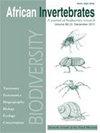南非夸祖鲁-纳塔尔省中部地区农业生态系统中蚯蚓种类的分布
IF 1.1
4区 农林科学
Q3 ENTOMOLOGY
引用次数: 0
摘要
尽管蚯蚓提供土壤生态系统服务,是生境变化的有用生物指标,但对南非农业生态系统中蚯蚓的物种组成知之甚少。考虑到土地利用和管理对生物多样性的影响,本研究的目的是记录发生在夸祖鲁-纳塔尔省中部地区耕地下的蚯蚓物种。2018年至2020年期间,对9个实行保护性农业的农场进行了调查。在田间共记录到4科12种蚯蚓,分别为:棘蚓科(Dichogaster bolaui)、鼻蚓科(pontocolex corenthrurus)、蚓科(aptorectodea caliginosa)、玫瑰蚓科(aptorectodea rosesea)、斜蚓科(aptorectodea trapezoides)、风纹蚓科(Lumbricus rubellus)、蓝蚓科(octolicum cyanum)、乳蚓科(octolicum lacteum)、大蚓科(Amynthas aeruginosus)、皮质蚓科(Amynthas corticis)、长尾蚓科(Amynthas gracilis)和土生蚓科(Tritogeniidae)。作物(生境)类型对蚯蚓物种丰富度和丰度均有显著影响。然而,事后结果显示大豆和玉米之间的物种丰富度存在差异,玉米的物种丰富度更高。研究结果表明,生境类型对农业生态系统中蚯蚓的群落有重要影响。本文章由计算机程序翻译,如有差异,请以英文原文为准。
Earthworm species occurrence in agroecosystems in the Midlands, KwaZulu-Natal, South Africa
Little is known about the species composition of earthworms in agroecosystems in South Africa even though earthworms provide soil ecosystem services and are useful biological indicators of changes in the habitats. Given the land use and management impact biodiversity, the aim of this study was to document earthworm species that occur under cultivated land in the KwaZulu-Natal Midlands. A survey of nine farms that practise conservation agriculture was carried out between 2018 and 2020. Twelve earthworm species belonging to four introduced families: Acanthodrilidae (Dichogaster bolaui), Rhinodrilidae (Pontoscolex corenthrurus), Lumbricidae (Aporrectodea caliginosa, Aporrectodea rosea, Aporrectodea trapezoides, Lumbricus rubellus, Octolasion cyaneum, Octolasion lacteum), Megascolecidae (Amynthas aeruginosus, Amynthas corticis, Amynthas gracilis, Amynthas rodericensis) and juveniles from an indigenous family Tritogeniidae were recorded from cultivated fields. The type of crop (habitat) affected both species richness and abundance of earthworms significantly. However, post hoc results showed differences in species richness between the soya and the maize only, with greater species richness in the maize. Our results demonstrate that habitat type has a major influence on communities of earthworms in agroecosystems.
求助全文
通过发布文献求助,成功后即可免费获取论文全文。
去求助
来源期刊

African Invertebrates
生物-动物学
CiteScore
1.00
自引率
0.00%
发文量
6
审稿时长
>12 weeks
期刊介绍:
African Invertebrates is an international peer-reviewed, open-access journal that focuses primarily on the taxonomy, systematics, biogeography, and palaeontology of Afrotropical invertebrates, whether terrestrial, freshwater or marine. Aspects concerning biology, ecology, and conservation may also be considered where these relate to the primary focus areas. Papers dealing solely with biology, ecology, physiology, pests and pest control should be submitted elsewhere.
 求助内容:
求助内容: 应助结果提醒方式:
应助结果提醒方式:


